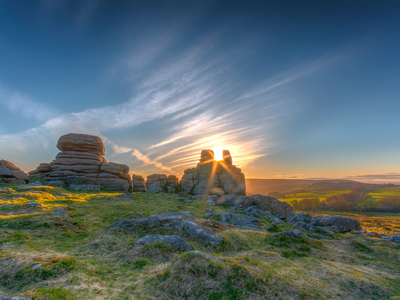
Rock Types and the Landscape
Different rocks create contrasting landforms and landscapes. Some of the most common rocks in Britain are granite, chalk, clay and Carboniferous limestone. For the GCSE, you will have made some case studies of several areas, each with a different geology, to learn about the features associated with these types of rock. You will also have studied how we use these areas, but this quiz is only concerned with helping you to revise about the landforms and how they are linked to the properties of the underlying rocks.
Granite is an igneous rock that underlies a lot of highland Scotland and the south-west peninsula of England (Devon and Cornwall). Dartmoor is a good example of a typical granite landscape. Exposures of granite are the tops of batholiths and this usually produces flat-topped moorland areas.
Granite is an impermeable rock and so there is a high drainage density, in other words, there are a lot of rivers and streams. Granite is resistant to weathering so usually forms upland areas, Dartmoor is no exception. There is a lot of rainfall so there are peat bogs and areas of standing water on the surface. Valleys are usually noticeably V-shaped with fairly steep sides and on a map, the contour lines are close together as the slopes tend to be steep.
Carboniferous limestone makes up a large part of the Pennines. It is a sedimentary rock made up mainly from one mineral - calcium carbonate. This is soluble in acids and so it will slowly dissolve in rainwater (which is slightly acidic). The structure of limestone is a bit like building blocks. There are vertical joints and horizontal bedding planes. These allow water to seep in (we say limestone is a permeable rock) and so limestone areas have a low drainage density and there can be underground rivers. As the rainwater dissolves the limestone, the joints and bedding planes can become enlarged. At the surface, this creates limestone pavement and swallow holes (some swallow holes have streams that flow into them). Underground, pothole systems and caves with stalactites and stalagmites form. Other key features are dry valleys and gorges caused where cave rooves have collapsed.
Chalk is made from the same mineral as limestone but in a different way. Chalk hills are usually called 'downs' and have dry valleys that were formed when the ice from the last ice age melted. Chalk is porous so surface water seeps into the ground and drainage density is very low. In some places, the chalk is underlain by impermeable rock and the water reappears as springs. Where chalk hills meet the sea, tall, vertical white cliffs are formed, for example, the seven sisters in East Sussex. The South Downs is a good example of a chalk area.
Clay is often associated with chalk and is a sedimentary rock that is made from extremely fine particles from the weathering of older rocks. It forms gentle flat or undulating landscapes that are easily waterlogged after rain as clay is effectively impermeable. It has a high drainage density and is rich in nutrients.
Ready for more?
not all...
quizzers. Try to win a coveted spot on our Hall of Fame Page.







